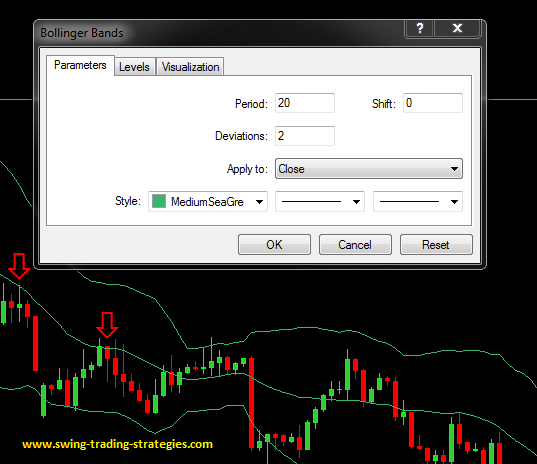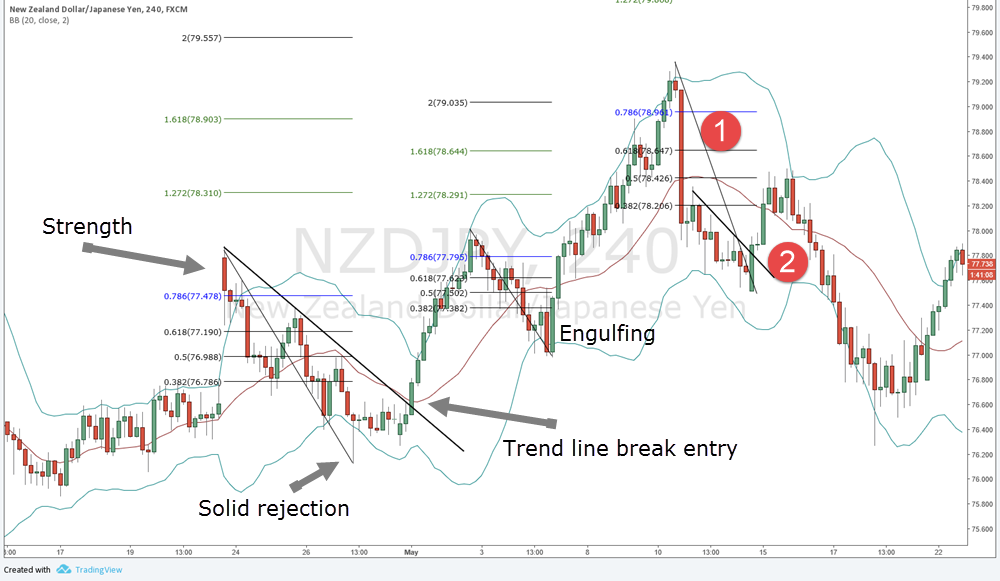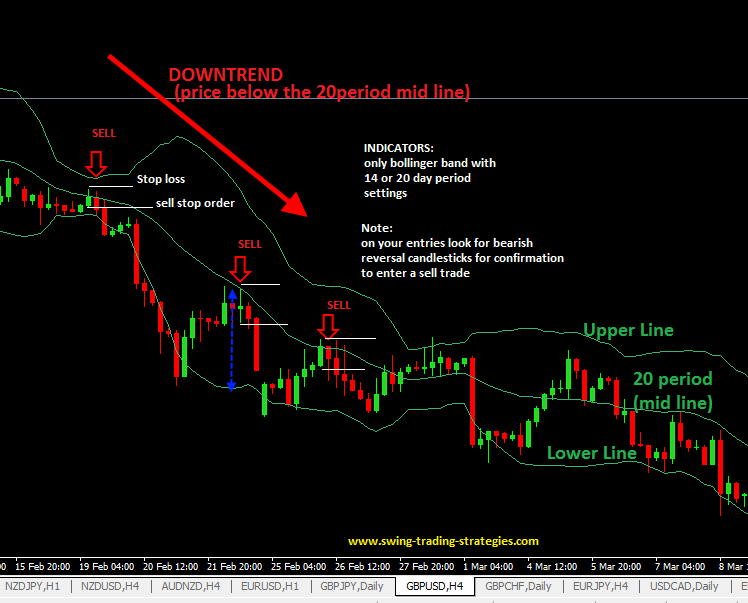This bollinger band strategy is a continuation trading strategy that also uses the 20 period moving average of the bands for trend direction. Bollinger bands are a good measure of volatility of the instrument you are trading and we can use this to form the basis of a swing trading system for Forex or any other market.
Bollinger Bands Indicator
The bollinger bands is made up of three lines: Top band, middle band, and lower band.
Using the standard bollinger band setting for this strategy, the lines are:
- Top line is 2 standard deviations from the middle line to the upside
- The middle line is a 20 period moving average
- Lower line is 2 standard deviations to the downside from the moving average

Bollinger Bands Standard Settings
Before you start changing the bollinger band settings looking for the best settings……I will tell you that there is no “best” setting and anybody trying to sell you the perfect setting (or a secret bank setting) is dishonest.
The theory is that the settings of the top and lower bands (the standard deviation from the moving average) contain price action. Any price movement that touches or exceeds the upper or lower band show a market that has increased volatility. This often can set up some great trading opportunities.
The bollinger bands are a technical indicator similar to the keltner channel as they are both bands and a measure of volatility. One main difference is the keltner channel uses average true range for the calculation. Unlike bollinger bands, keltner channels after a big price movement does not have the “balloon” effect that the bollinger has.
Trading Rules Of Bollinger Band Strategy
Let’s understand the “moving parts” of this strategy before you move onto the entry rules. You can use the bollinger band strategy on any time frame but like most trading signals, a higher time frame trade setup is often more reliable.
- If price is moving below the 20 period middle line then the market is in a downtrend.
- If price is moving above the 20 period , consider the market is in an uptrend.
- Use the angle of the middle line if price exceeds the moving average.
Bollinger band buy signal
We need to see price moving above the middle line of the bollinger band. Once we see price moving in that direction, we’d like to see price pierce the upper band and begin to pull back
You want to see price pullback into the area of the middle line to initiate a buy signal. You will then look for a price action setup that shows price has a probability of travelling back to the upside. You can also use an opposing trend line break for entry.
Bollinger band sell signal
For selling, we want to see price visit the lower part of the band and either touch or pierce the bands. From there, price pulls back into the area around the 20 period moving average middle line. You can also use an opposing trend line break for entry.
Like the buy signal, we want to see price action showing intent of moving back lower.
Where To Take Profits With Bollinger Bands
The bollinger bands actually have a built in indicator for profit taking: the outer bands.
One price has touched the middle line for a buy or sell signal, look for price to travel to the upper or lower band to take your trading profits.
You can also use a Fibonacci measurement for profit taking and trade management.

Bollinger Band Strategy With Fibs and Price Action
This is a more advanced bollinger band strategy as I am using a combination of technical analysis to trade this chart.
- Strength as price gapped up over the top bollinger band and price begins a complex correction
- Price gives a solid rejection of lows and rallies breaking a trend line
- Enter the trade a price break of the trend line
- Use a Fibonacci pull from high to low to project price to the upside
- Manage the trade at certain Fibonacci levels
For the second trade in this strategy, things are a little more clear:
- Price touches the upper band
- Price pulls back and you can infer a complex correction from the high shadow around the middle line
- Middle line still angles up.
- Price touches lower band and engulfing candle is entry
- Fibonacci pull and upside targets after resistance break is 1.27, 1.618 and 2.0
This last trade is interesting and a lesson about price movement you should never ignore:
- When you see such a bearish (or bullish) candlestick like this, you DO NOT want to trade against it. It shows, in this case, extreme weakness
- Look to position in the direction of the extreme candlestick (in this case bearish) around the middle line or upper (or lower band)
This highlights that while technical indicators such as the bollinger band can aid you in trading, price action will always rule.
This Bollinger Band Strategy Is Worth A Test
Bollinger bands can frame price and show you when there is an extreme move worth noting. Your trading system may require price movement touching or exceeding the upper or lower bands before taking a trade
You can use these as a mean reversion system or a continuation swing trading strategy. The mean reversion aspect is a more advanced bollinger strategy and is shown in the second trade example in the last chart.
Bollinger bands can keep you objective in your trading by offering you not only a place to consider a trade, but areas to consider taking profits as described above.
Whatever way you choose to use the bollinger bands as part of a swing trading strategy, ensure you test it and log a trade plan so you can stay on track.
Bollinger Bands And Price Compression
Another use of the bollinger bands is to measure price compression and a break from the consolidation. This is used in conjunction with the keltner channel and is called the squeeze. The Bollinger Band Squeeze can also be a trading system but like every trading method, test your idea before putting money on the line.
Please don’t forget to tweet and share this post by clicking those buttons below if you’ve enjoyed this.





 Posted in
Posted in